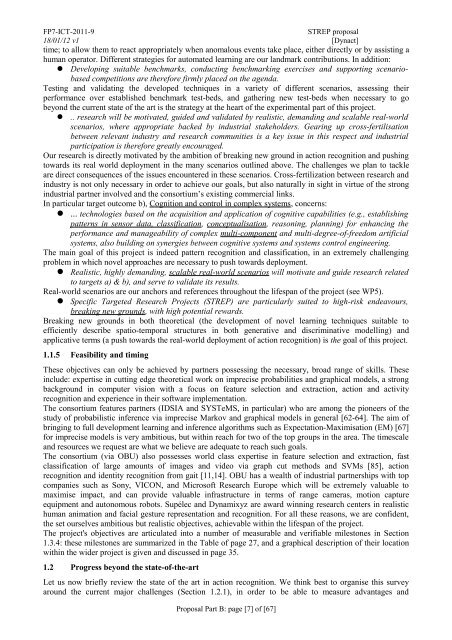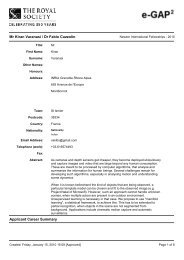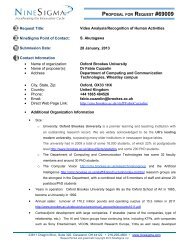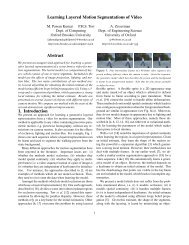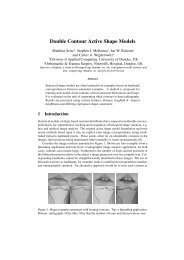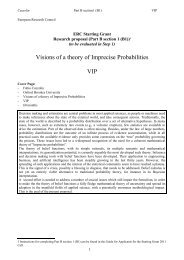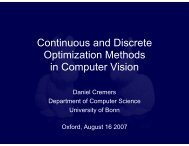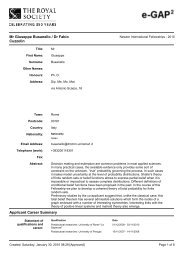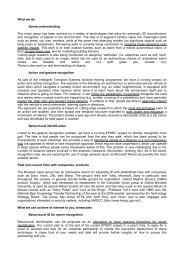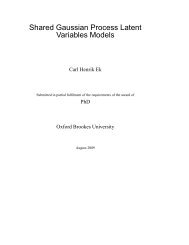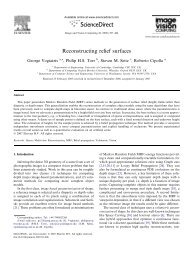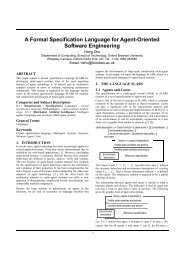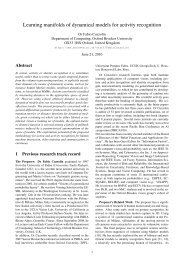Project Proposal (PDF) - Oxford Brookes University
Project Proposal (PDF) - Oxford Brookes University
Project Proposal (PDF) - Oxford Brookes University
You also want an ePaper? Increase the reach of your titles
YUMPU automatically turns print PDFs into web optimized ePapers that Google loves.
FP7-ICT-2011-9 STREP proposal<br />
18/01/12 v1 [Dynact]<br />
time; to allow them to react appropriately when anomalous events take place, either directly or by assisting a<br />
human operator. Different strategies for automated learning are our landmark contributions. In addition:<br />
Developing suitable benchmarks, conducting benchmarking exercises and supporting scenariobased<br />
competitions are therefore firmly placed on the agenda.<br />
Testing and validating the developed techniques in a variety of different scenarios, assessing their<br />
performance over established benchmark test-beds, and gathering new test-beds when necessary to go<br />
beyond the current state of the art is the strategy at the heart of the experimental part of this project.<br />
.. research will be motivated, guided and validated by realistic, demanding and scalable real-world<br />
scenarios, where appropriate backed by industrial stakeholders. Gearing up cross-fertilisation<br />
between relevant industry and research communities is a key issue in this respect and industrial<br />
participation is therefore greatly encouraged.<br />
Our research is directly motivated by the ambition of breaking new ground in action recognition and pushing<br />
towards its real world deployment in the many scenarios outlined above. The challenges we plan to tackle<br />
are direct consequences of the issues encountered in these scenarios. Cross-fertilization between research and<br />
industry is not only necessary in order to achieve our goals, but also naturally in sight in virtue of the strong<br />
industrial partner involved and the consortium’s existing commercial links.<br />
In particular target outcome b), Cognition and control in complex systems, concerns:<br />
... technologies based on the acquisition and application of cognitive capabilities (e.g., establishing<br />
patterns in sensor data, classification, conceptualisation, reasoning, planning) for enhancing the<br />
performance and manageability of complex multi-component and multi-degree-of-freedom artificial<br />
systems, also building on synergies between cognitive systems and systems control engineering.<br />
The main goal of this project is indeed pattern recognition and classification, in an extremely challenging<br />
problem in which novel approaches are necessary to push towards deployment.<br />
Realistic, highly demanding, scalable real-world scenarios will motivate and guide research related<br />
to targets a) & b), and serve to validate its results.<br />
Real-world scenarios are our anchors and references throughout the lifespan of the project (see WP5).<br />
Specific Targeted Research <strong>Project</strong>s (STREP) are particularly suited to high-risk endeavours,<br />
breaking new grounds, with high potential rewards.<br />
Breaking new grounds in both theoretical (the development of novel learning techniques suitable to<br />
efficiently describe spatio-temporal structures in both generative and discriminative modelling) and<br />
applicative terms (a push towards the real-world deployment of action recognition) is the goal of this project.<br />
1.1.5 Feasibility and timing<br />
These objectives can only be achieved by partners possessing the necessary, broad range of skills. These<br />
include: expertise in cutting edge theoretical work on imprecise probabilities and graphical models, a strong<br />
background in computer vision with a focus on feature selection and extraction, action and activity<br />
recognition and experience in their software implementation.<br />
The consortium features partners (IDSIA and SYSTeMS, in particular) who are among the pioneers of the<br />
study of probabilistic inference via imprecise Markov and graphical models in general [62-64]. The aim of<br />
bringing to full development learning and inference algorithms such as Expectation-Maximisation (EM) [67]<br />
for imprecise models is very ambitious, but within reach for two of the top groups in the area. The timescale<br />
and resources we request are what we believe are adequate to reach such goals.<br />
The consortium (via OBU) also possesses world class expertise in feature selection and extraction, fast<br />
classification of large amounts of images and video via graph cut methods and SVMs [85], action<br />
recognition and identity recognition from gait [11,14]. OBU has a wealth of industrial partnerships with top<br />
companies such as Sony, VICON, and Microsoft Research Europe which will be extremely valuable to<br />
maximise impact, and can provide valuable infrastructure in terms of range cameras, motion capture<br />
equipment and autonomous robots. Supélec and Dynamixyz are award winning research centers in realistic<br />
human animation and facial gesture representation and recognition. For all these reasons, we are confident,<br />
the set ourselves ambitious but realistic objectives, achievable within the lifespan of the project.<br />
The project's objectives are articulated into a number of measurable and verifiable milestones in Section<br />
1.3.4: these milestones are summarized in the Table of page 27, and a graphical description of their location<br />
within the wider project is given and discussed in page 35.<br />
1.2 Progress beyond the state-of-the-art<br />
Let us now briefly review the state of the art in action recognition. We think best to organise this survey<br />
around the current major challenges (Section 1.2.1), in order to be able to measure advantages and<br />
<strong>Proposal</strong> Part B: page [7] of [67]


